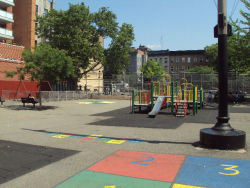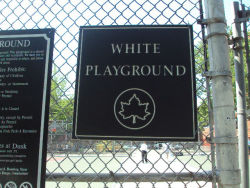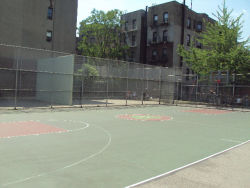White Playground
White Playground
What was here before?
The area, which became known as East Harlem, was rural for most of the 19th century. The construction of the elevated transit line to Harlem in 1879-1880, and the extension of the Interborough Rapid Transit line in 1918, urbanized the area.
How did this site become a playground?
This small playground has been a part of the Harlem community since the early twentieth century. The Italian Benevolent Institute was the first organization to operate a playground on this site. In 1936, the City of New York acquired a 0.52-acre plot of land from the Institute and transferred jurisdiction over the property to NYC Parks. In the following years, Parks lobbied to acquire more land and in 1942, the park became its current size to accommodate the expanding community.
Who is this playground named for?
This playground honors renowned civil rights activist and author Walter Francis White (1893-1955).
White was born in Atlanta, Georgia on July 1, 1893. An African American with fair skin, blond hair, and blue eyes, White could have passed as being white but instead chose to live proudly as an African American, championing the cause of civil rights and exploiting his appearance to investigate lynchings and race riots.
At age 25, White became Executive Assistant Secretary of the fledgling National Association for the Advancement of Colored People (NAACP). Eighteen years later, he was appointed the Executive Secretary of the organization. During his tenure, White expanded the number of NAACP branches, increased the membership to more than 500,000, and helped found the Legal Defense and Education Funds, which fought for social integration in the 1950s and 1960s.
During World War II (1939-1945), White served as a special correspondent for the New York Post in Europe and Japan. He was also an accomplished author of both fiction and nonfiction. His most widely-read works were two fictionalized accounts of Southern lynchings, Fire in the Flint (1924) and Rope and Faggot: A Biography of Judge Lynch (1929), as well as his acclaimed autobiography, A Man Called White (1948). In 1937, White received the Spingarn Medal, a prestigious NAACP award, in recognition of his efforts to improve the lives of African Americans. Eight years later, he served as a consultant to the United States delegation at the organizational meeting of the United Nations in San Francisco. White died in New York in 1955.
Check out your park's Vital Signs
Clean & Safe
Green & Resilient
Empowered & Engaged Users
Share your feedback or learn more about how this park is part of a
Vital Park System




